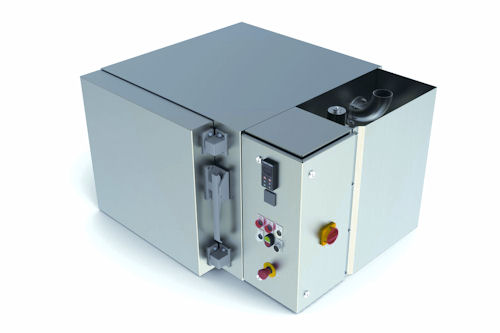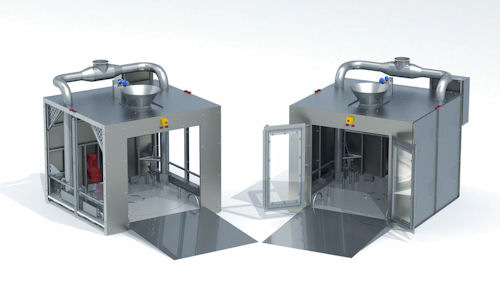April 9, 2013
The greeting over the front door at Cryogenic Equipment Services (CES) reads: “We love the cold.” While many may feel differently about the outdoor temperature, most people adore the frozen foods that are created with CES’ industrial freezing and production chilling equipment. In addition to making the equipment used to produce ice cream cakes, frozen pizzas and heat and-serve entrees, CES is a leading manufacturer of cryogenic freezers for pharmaceutical and metal treatment applications.
 |
CES’ products fall within three categories: linear tunnels, through which product travels along a conveyor sprayed with liquid nitrogen; spiral freezers, which are driven by belt-and-drum systems to keep product continuously moving; and walk-in batch freezers. Designing and manufacturing all three types of chilling equipment requires large-assembly design and production, and sheet-metal design and fabrication solutions.
Until 2007, CES used 2D design tools. However, as demand for custom-designed systems, shorter lead times and greater accuracy grew, so did the company’s need for a 3D development platform.
“Growing the company required faster design and production, particularly with how we handle sheet metal,” explains Design Engineer Ed Scheid. “Roughly 80% of what we do is sheet-metal work, and by moving to a 3D system, CES anticipated that designing parts, making flat patterns, and laser-cutting pieces would be faster, more accurate, and less costly.”
 |
The CES facility in Cincinnati followed its parent company in Belgium, which had moved to SolidWorks Professional design software.
“Our colleagues in Belgium chose SolidWorks because it’s easy to use, has robust sheet-metal design and fabrication capabilities, and includes advanced design visualization tools,” Scheid notes. “We also recognized the value of using SolidWorks visuals to facilitate our sales process.”
Accelerating Development through Production
Since implementing SolidWorks Professional software, Scheid reports, CES has cut the time from initial design through final production in half. In addition to realizing productivity gains in sheet-metal design and fabrication, the manufacturer has experienced improvements in developing large assemblies and resolving potential clearance issues.
“Some of our freezers total 10,000 parts,” Scheid points out. “Whether we’re working with 2,000- or 10,000-part assemblies, SolidWorks gives us the tools we need to accelerate large-assembly design. Our products are different for every customer, and the improvements we’ve seen with assembly and sheet-metal design allow us to deliver products faster and of more consistent quality.”
Improved Accuracy Saves Time and Material
Using SolidWorks sheet-metal design tools, CES has not only carved time from its development process, but is also maximizing material usage “reducing scrap and rework. Because sheet-metal parts are more accurate with SolidWorks, the company has greater confidence in its flat patterns, and has eliminated grinding and retrofitting operations on the shop floor.
“When I design a sheet-metal part in SolidWorks, it’s probably within a couple thousandths of an inch of what I design it to be, so that when it comes off the laser and gets bent, there is very little scrap and we can weld everything up exactly,” Scheid explains. “Instead of just putting one large flat pattern on a sheet, we can add other smaller pieces. Because we know the parts are very accurate, we can use the material more effectively.
“What we see on the screen in SolidWorks is exactly what the part is going to be,” Scheid continues. “If it fits in SolidWorks, we know that it fits. That confidence really speeds up our manufacturing operations.”
Visualizing Equipment Performance
CES also leverages SolidWorks design visualization tools to streamline sales efforts, improve customer communications, and pinpoint potential performance issues. Photorealistic renderings created with PhotoView 360 are a boon to sales presentations, Scheid points out. More technically detailed eDrawings files help customers fully understand how their particular system will work. In addition, the design visualization in SolidWorks software helps designers learn things about how the equipment will operate. For example, Scheid discovered the need for additional clearance on a spiral freezer for a customer’s ice cream cakes.
“When a cake goes through the spiral, the slope changes from flat level to an inclined slope. Within the transition from the flat to the raised slope, you actually need more clearance than when it’s moving on a flat conveyor,” Scheid explains. “With SolidWorks, we were able to visualize that phenomenon and increase the clearance before we released it to manufacturing. With SolidWorks, we can take advantage of design visualization from the beginning of the sales process through concept development into production, and communicate effectively with customers along the way.”
Info
For more information on this topic, visit deskeng.com.
Subscribe to our FREE magazine, FREE email newsletters or both!
About the Author
DE’s editors contribute news and new product announcements to Digital Engineering.
Press releases may be sent to them via [email protected].






